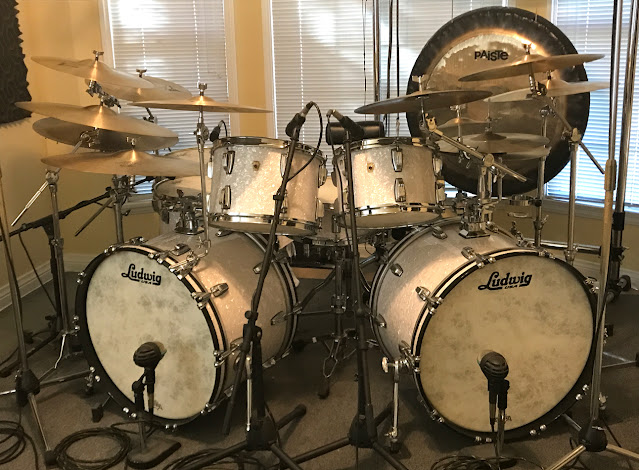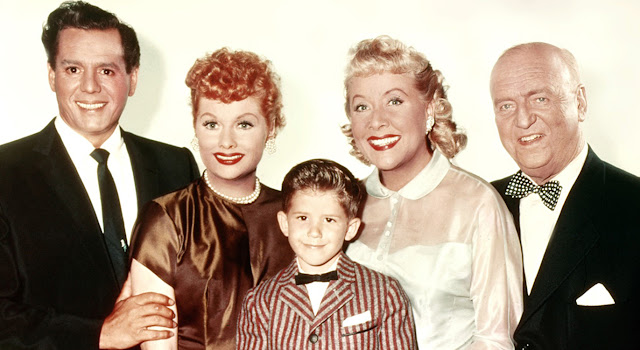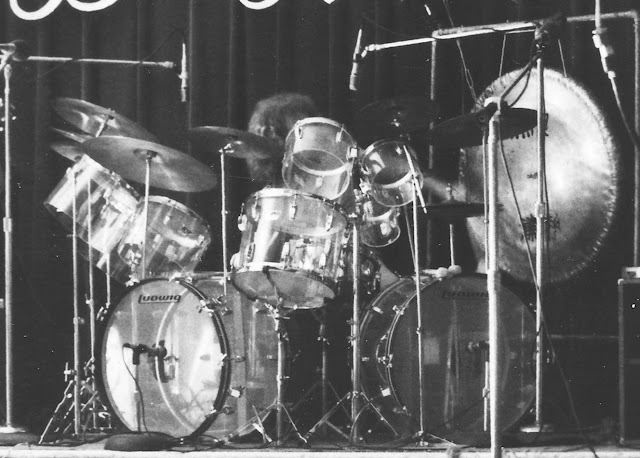My Drumsets, Part 6: Ludwig Legacy Maple (2013 – Present Day)
Ludwig Legacy Maple series (white-marine pearl wrap)
Configuration: Two bass drums, two small toms, two floor toms, snare drum
• Two 22” x 14” bass drums, 12” x 8” and 13" x 9" small toms, 14" x 14" and 16" x 14" floor toms, 14” x 5” brass-on-brass Black Beauty snare drum, 14" x 5" Rogers Dyna-Sonic snare drum
• Ludwig hardware and stands; Tama throne; DW9000 pedals; Gibraltar legless hi-hat
• All-Zildjian cymbal setup
In 2002 I had finally put together a home studio (Yard Dog 1) and my Ludwig Classic drums were so big and aggressive sounding that they proved to be less than ideal for use in a small home studio. Plus, they were so large (especially the 26”x16” bass drums) that when I downsized from an SUV to a sedan in 2009 I couldn't get the full drumset in my car, which forced me to revert to a four-drum ‘Krupa-Standard' configuration when I played the occasional gig. (Not nearly as much fun to play as my full seven-drum configuration.)
If I hadn't sold my red-rosewood Gretschs in 1995 I wouldn't have felt the need to buy a new drumset to use in my studio. But as things happened, early in 2013 I lost my job and my (second) wife walked out on me — on the same day! So by the end of that year I found myself living alone in my home. And (after finding an even better job) what does A Drummer do when they have the house all to themselves? They take two bedrooms and dedicate them to playing and recording the drums! That was the birth of my current studio (Yard Dog 2), and I needed a drumset that was more studio-friendly to use in it. (Plus, after such a rough year I wanted to give myself the gift of a new drumset.)
To this day I remain a confirmed "Ludwig guy", and
during the 23 years between 1990 (when my Sable-Black Ludwig Classic drumset was made) and 2013,
Ludwig had refined their manufacturing processes to the point where the Legacy
Maple series drums they produce in their North-Carolina factory are equal to the quality of
the best drums made by anyone, anywhere in the world.
The Legacy Maple series’ 3-ply maple/poplar/maple shells with maple reinforcement ring* construction was originally introduced by Ludwig in 1968 to provide drummers with an instrument that could better keep up with the increased amplification being used at the time. This particular 3-ply shell construction lasted until 1976, when Ludwig began offering their heavy 6-ply 'Classic' shell configuration. Ludwig continued to exclusively offer heavy multi-ply shells until 2009, when they re-introduced a version of their 3-ply 1968-vintage Legacy Maple shell that is built using more modern manufacturing techniques than were available between 1968 and 1976.
*Drums with thinner shells are traditionally constructed with a wood reinforcement ring glued around each end to stiffen the shell, helping to maintain the drum’s round shape and withstand the tension from the drumheads.
The Legacy Maple shell construction promised to be an ideal sonic fit for both my home studio and any stage work I would ever take on. A new kit would also enable me to get smaller drums, allowing the whole kit to once again fit into my car. Just for shits and grins, I got small toms and floor toms that are identical sizes to the ones that Ginger Baker had on the two Ludwig drumsets he used with CREAM between 1966 and 1968. (Ginger used 14" x 14" and 16" x 14" floor toms, small sizes for rock music.) To this day Ginger still remains a huge influence on my drumming.
I opted for white-marine pearl wrap, which is the most classic drum finish of them all and one that I had always liked (plus, by 2013 Ludwig had finally switched from the ghastly ‘wrap-around’ white-marine pearl they'd been using since the late 1940s to a much more attractive ‘small-chip’ version of the finish). My 23-year old Pearl hardware was worn-out so I replaced it with light-weight Ludwig flat-base cymbal stands for portability and Ludwig's top-line heavy snare stand, which is the absolute best snare stand I've ever used — period.
The Ludwig Atlas LAP23SSL is hands-down the best snare drum stand I've ever used — it's the only stand that doesn't 'dance around' on the floor while I'm playing the snare drum.
After trying every bass drum pedal I could put my feet on, I got a new pair of DW9000 pedals to go with my Legacy Maple drumset, and they've proven to be the smoothest, most natural-feeling pedals I've ever used. They have even more adjustments than my old Rogers Swiv-O-Matic pedals so I can dial in each one perfectly for each foot, and they provide a combination of power and finesse that's ideal for my playing style.
I originally ordered this drumset with a Ludwig LB416BT "brass-on-brass" Black Beauty brass-shelled snare drum, and it's the best metal-shelled snare drum I've ever played — it's sensitive yet capable of tremendous power, it has wonderful musical tone, cast hoops that produce killer rimshots, and is easy to play. But being a metal-shelled drum it has a bit too strong a voice of its own that doesn't always blend as well as I would like with my wood-shelled drumset. When I bought my wood-shelled Rogers Dyna-Sonic snare drum in 2019 (see My All-Time Favorite Snare Drum) I found the ideal snare drum to go along with my Legacy Maple bass drums, tom-toms and floor toms. I did hold onto my Black Beauty snare, since: a) I could easily find myself in a playing situation where its sound would work better than the Dyna-Sonic's sound, and b) As with cymbals, you can never have too many snare drums.
Upon taking delivery of these drums, instead of immediately swapping the Ludwig-made factory drumheads for Remos as I had done on my previous two Ludwig drumsets, I decided to keep the Ludwig heads on the drums and see if I could get a good sound with them. After weeks of trying every imaginable tuning the drums continued to sound thin and relatively toneless. As soon as I installed my preferred Remo Fiberskyn 3 heads the drums sprang to life with a warm, woody and full sound. (As I said in an earlier post, I should always trust my instincts when it comes to my drums!)
As of this writing I’ve been playing this drumset for more than twelve years, and it is without question the best sounding and most well-made instrument I’ve ever owned. The drums sound superb tuned high or low, combining the perfect amount of woody ‘bark’ in their attack with plenty of fullness. Unlike the Japanese brands (which to my ear all sound like generic 'McDrums'), my Legacy Maples definitely have their own distinct sonic personality, which I love. And they record beautifully. Every day I cannot wait to sit down and make music with them.
Current cymbals (1993 – 2025)
My cymbal setup has been continually evolving ever since I bought my first Zildjian cymbal from a pawn shop in 1966. In particular, I’ve always loved the sound of the thinner crash cymbals that Zildjian made during the 1960s, but during the 1970s and 1980s Zildjian increased the weight and slightly altered the profiles of their A-series crash and ride cymbals because so many drummers were hitting hard and breaking the thinner ones (as I had done back in 1974 — see Part 3 of this series). The trouble is, heavier cymbals just don’t sound very good (at least, they don’t sound very good to me), having a ‘clangy’ attack, ‘gongy’ overtones and requiring that they be struck hard to respond fully.
Since my drumming restart in 1984 I had been using a
combination of K Zildjian crashes and a few carefully-selected A
Zildjian crashes, along with K Zildjian ride cymbals. However, I was never
totally satisfied with this; I was always searching for the elusive sound and
feel of those older ‘60s A Zildjian crashes.
In 2013 Zildjian completely redesigned their A-Zildjian
cymbal line, removing some of the weight and altering the profiles to bring the
instruments’ sound and response more in line with what the company offered in
the 1950s and 1960s. So between 2016 and 2022 I replaced all of my K-series and ‘90s-era
A-series crash cymbals with post-2013 redesign A-series crashes, and I now have
what I think is the best-sounding and most versatile cymbal setup I’ve ever used.
• 18” A Avedis Thin Crash (2020)
• 15” K Sweet Hi-Hats (2021)
• 18” A Medium-Thin Crash (high pitched, 2021)
• 10” K Custom Dark Splash (partially obscured by 18" Medium-Thin Crash, 2023)
• 16” A Thin Crash (2016)
• 17” A Thin Crash (2020)
• 20” A Crash-Ride (2023) or 20” A 'Take Five' Ride (2022) or 20" K Custom Dark Crash (used as crash-ride, 2023)
• 22" K Constantinople Bounce Ride (2020) or 22” K Ride (2015) or 22" K Heavy Ride (1988) or 22" A Avedis Ride (2024)
• Above: 18" A Medium-Thin Crash (medium pitched, 2021)
• Below: 22” A Swish
Knocker (1995)
• 18” A Thin Crash (2021)
I also have an 18" A Medium Crash (2021) and a 17" K China Boy (1986) that I may occasionally swap with a couple of the above 18" crashes, depending on musical requirements.
My Zildjian 22" K-Constantinople Bounce ride cymbal, showing the complex hammering on the top (left) and bottom (right) that help give this cymbal its unique sound and playing characteristics. As with all Zildjian cymbals, no two 22" Bounce ride cymbals sound identical.
Added in 2014:
• 34” Paiste
symphonic gong
Although I was heartbroken when my original Paiste gong was stolen in 1977 (see Part 3 of this series), at the time I simply couldn't afford to replace it, and after I retired from playing professionally later that year I honestly didn't feel the need to replace it. It wasn't until I began playing with Greg Segal in the duo Jugalbandi in 1993 that I began using a 21" diameter Rancan (Chinese) flat gong with my Ludwig Classic drumset. At the time I knew that it was only a placeholder instrument, having limited power and being able to produce only a single — very crashy — gong sound.
I fell in love with the sound of Paiste gongs while playing one in the percussion section of the Valley College symphony orchestra during Mussorgsky's "Pictures At An Exhibition".
In 2014, a year after bought my Legacy Maple drumset and turned part of my house into Yard Dog 2 studio, I decided to splurge and finally replace my long-lost Paiste gong. Although I originally wanted a 36" diameter instrument, Paiste didn't have any that size in the USA at the time and it would've taken months to get one from Germany. (All Paiste gongs are hand made at the company's German gong factory by a crew of only eight people.) However they did have a 34" gong in stock, and since that was the size of my original gong, I figured that my gong karma had destined me to play a 34" gong so I had Professional Drum Shop order it for me.
The new gong is a much better instrument than the old 1960s-vintage one that I bought in 1972 (see Part 2 of this series). My old gong was capable of producing strong crashes, but I think that instrument had been whacked in the same spot so many times before I bought it that it lost some of the built-in tension that makes gongs and cymbals work; compared with my new gong the old one sounded kind of tired.
The new gong is capable of creating a vast array of different sounds and can speak at a whisper or roar at a deafening volume. I can bring out different sounds from it by using all sorts of different implements to play it. Hits with conventional gong mallets can produce anything from a soft deep-bass rumble to a full-bore crash; rolls with concert bass-drum mallets can create sustained tension or all manner of different swells; rubbing the gong's surface with small rubber-headed mallets creates pitch-bent bursts that sound like underwater whale voices. Besides the drumset (which is really a collection of different instruments), my Paiste gong is by far the most complex-sounding single percussion instrument that I've ever played.
-Hyam R. Sosnow










Comments
Post a Comment